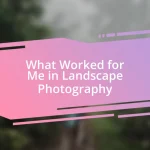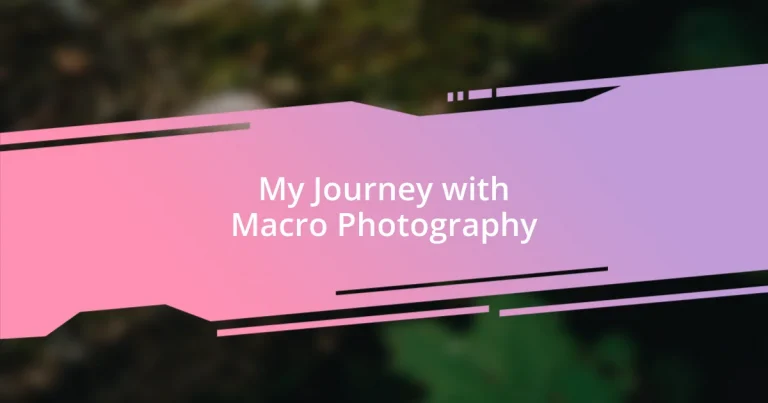Key takeaways:
- Understanding macro photography requires the right equipment, with essential items including a macro lens, extension tubes, a tripod, and proper lighting.
- Technique plays a crucial role in capturing details, utilizing methods such as texture focus, shallow depth of field, and focus stacking to enhance images.
- Post-processing is essential for refining images, allowing photographers to reveal hidden details and evoke emotions, while sharing experiences fosters community and learning among macro enthusiasts.
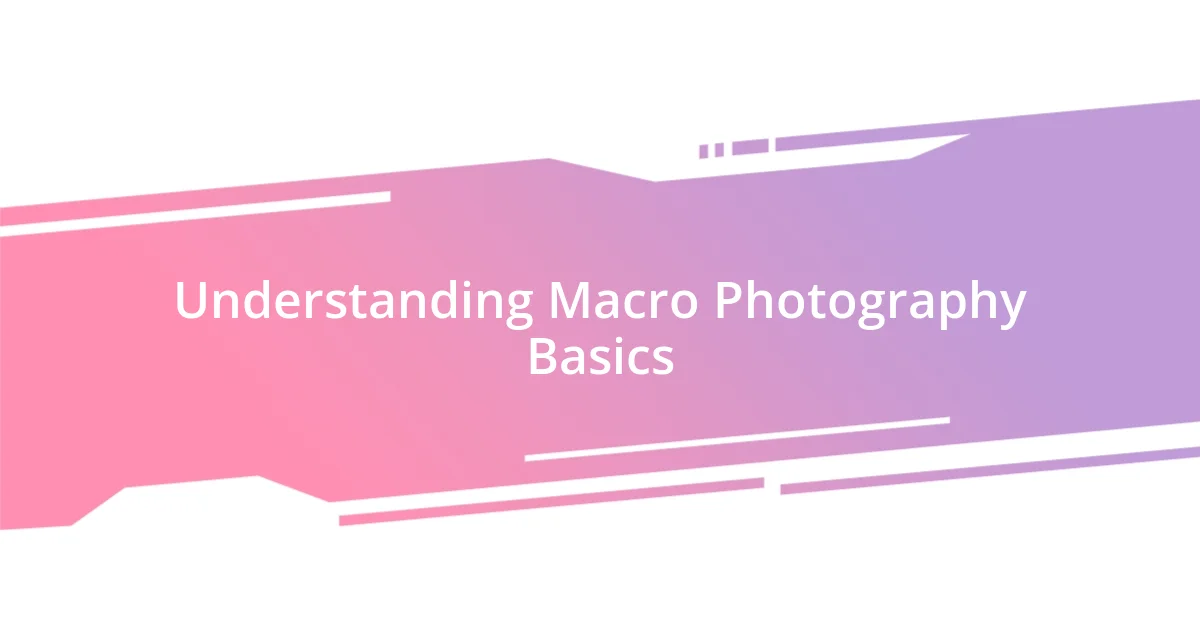
Understanding Macro Photography Basics
When I first dabbled in macro photography, I was astonished by the level of detail I could capture. The world shrinks to a whole new scale, revealing textures and colors I never noticed before. It made me wonder—what else was hidden in plain sight, just waiting for the right lens to uncover it?
Understanding macro photography basics starts with the right equipment, typically a macro lens or a dedicated extension tube. The ratio of 1:1 is often discussed, meaning the subject is captured at life size on the sensor. I remember my first attempt at shooting a dew-covered spiderweb; with a 100mm macro lens, each droplet sparkled like a diamond, making me realize the magic that precision can bring.
Light is another crucial aspect of macro photography. Natural light works wonders, but using a flash can help illuminate details that might otherwise go unnoticed. I vividly recall experimenting with soft diffused light on a flower—each petal came alive, showcasing subtle details that tugged at my creative heartstrings. Have you ever thought about how light transforms your subjects? It truly becomes a dance between your camera and the environment.

Choosing the Right Equipment
Choosing the right equipment can feel overwhelming, especially with so many options available, but I’ve learned that the best gear doesn’t have to break the bank. When I first started, I experimented with different lenses and setups, discovering that a solid macro lens is crucial for achieving those crisp, detailed shots. I fondly remember the day I borrowed a friend’s 60mm macro lens; that’s when I truly felt like I had discovered the key to capturing the intricate details of a tiny bug munching on a leaf.
Here are some essential items to consider when diving into macro photography:
- Macro Lens: A lens specifically designed for close-up work; usually available in 50mm, 60mm, 100mm, and 180mm lengths.
- Extension Tubes: These hollow tubes fit between your camera body and lens, allowing for closer focusing.
- Tripod: A stable base is vital since even the slightest movement can blur your image at extreme close-ups.
- Macro Lighting: LED ring lights or diffused softboxes can enhance contrast and bring out textures.
- Focusing Rail: This allows for precise adjustments, especially when working with very shallow depth of field.
Every bit of gear contributes meaningfully to bringing your vision to life. I can still recall the thrill of realizing what a good tripod could do for my long exposures during those magical twilight hours in my garden. Suddenly, my once wobbly compositions turned sharp and composed, revealing depths I’d only dreamed of capturing. It’s moments like these that remind me that the right equipment isn’t just useful; it’s transformative.

Techniques for Capturing Details
Capturing the intricate details in macro photography is an adventure in itself. One of the techniques I frequently use is focusing on texture. For instance, when I shot a close-up of a butterfly’s wing, I was amazed by how its scales shimmered in the light. This level of detail isn’t just beautiful; it invites the viewer to appreciate the subject in a whole new way. Often, I find that taking multiple shots at different angles reveals more layers of detail. Have you ever noticed how a slight change in perspective can enhance the depth of your images?
Using a shallow depth of field is another method that has enriched my macro work. By focusing on a particular element while blurring the background, I can draw attention to the details that matter most. I remember photographing a dewdrop on the blade of grass; the world behind it melted softly into a warm blur. This technique helps create an enchanting atmosphere, making the subject appear almost ethereal. The more I practice, the more I realize how effective these small adjustments can be in telling a story through my photos.
Experimenting with focus stacking has opened doors to capturing detail that was once out of reach for me. Originally, I would struggle to keep everything in focus while shooting a delicate flower. Then I discovered focus stacking, where I’d take multiple images at different focus points and merge them in post-processing. The first time I tried it, I was thrilled to see how every petal was sharp and clear, revealing intricate patterns that left me in awe. It’s a technique that not only elevates the quality of my work but also enhances my understanding of the subjects I photograph.
| Technique | Description |
|---|---|
| Texture Focus | Emphasizing the subject’s surface details to engage viewers. |
| Shallow Depth of Field | Blurring backgrounds to highlight main subjects and create depth. |
| Focus Stacking | Taking multiple shots at different focus points for sharp, detailed images. |
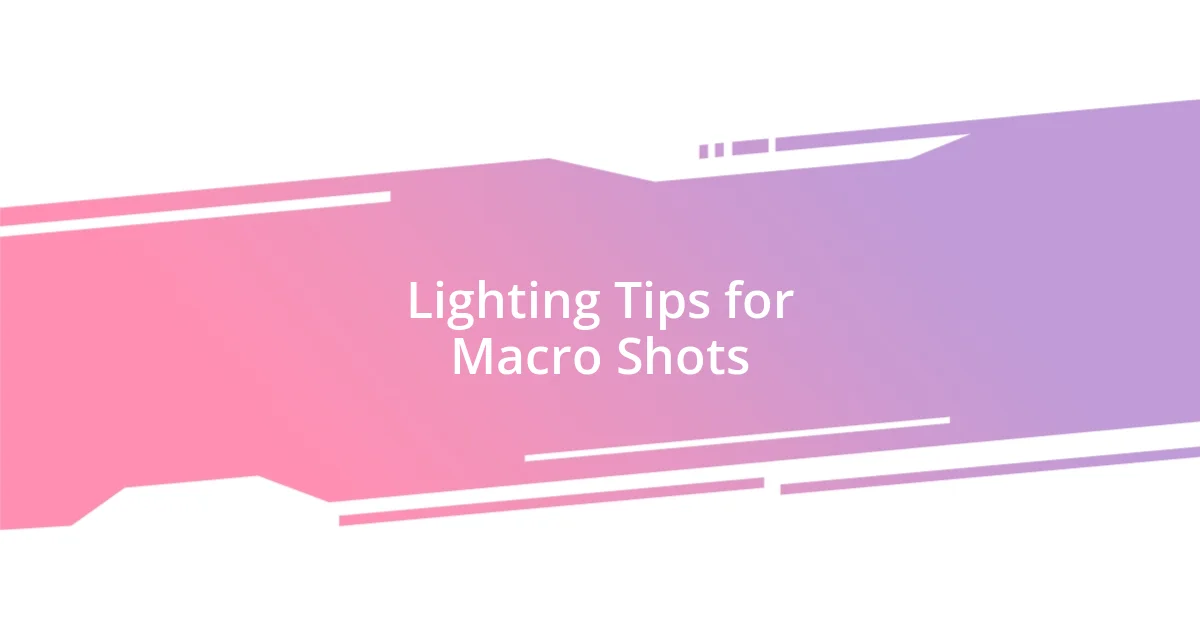
Lighting Tips for Macro Shots
When it comes to lighting for macro photography, I quickly learned that natural light can be my best friend or worst enemy. Soft, diffused light—like what you’d find on an overcast day—brings out the subtleties in texture without casting harsh shadows. I remember one afternoon, wandering through a park, and seeing tiny flowers glistening after a light rain. The way the diffused sunlight illuminated each petal made the colors pop; it was a perfect moment and reminded me how crucial good lighting is for capturing inspiring images. Have you ever noticed how your mood changes depending on the light?
On the other hand, artificial lighting can open up a world of creativity. I often use a ring light or a flash with a diffuser to minimize harsh hotspots on subjects like insects. For instance, during a recent shoot, I experimented with a portable LED light to highlight the delicate veins of a leaf. It was incredible how a small adjustment in lighting completely transformed the atmosphere of my shots, giving them an almost magical quality. I was amazed at how something so simple could elevate my images dramatically.
Finally, the position of the light is essential in macro photography. I’ve found that placing the light at a 45-degree angle can enhance textures and details brilliantly. I recall a time when I was shooting a close-up of raindrops sitting on a flower petal. By adjusting the light’s angle, I revealed the intricate reflections within each droplet, making my photo feel like a tiny world encapsulated. It’s moments like this that highlight the profound impact lighting can have. So, how might you adjust your light to discover something new in your photography?

Composing Your Macro Images
When composing macro images, I often think about the rule of thirds and how it can drastically change the focus and feel of my photographs. For instance, when I positioned a ladybug off-center during a shoot, the photograph drew the viewer’s eye across the frame, inviting them to explore the surrounding foliage. It’s fascinating to see how simple adjustments to composition can transform a flat image into something dynamic and engaging, don’t you think?
Another technique that I’ve found valuable is leading lines. I remember photographing a delicate spiderweb draped across a flower. By including the stems as leading lines, I was able to guide the eye right to the center of the web. It’s moments like this that reinforce the idea that every small element in the frame plays a role in storytelling, creating a more immersive experience for the viewer.
Don’t underestimate the power of negative space either. During a recent shoot with a solitary dew drop on a leaf, I intentionally left a lot of empty space around it. This not only emphasized the drop but also evoked a sense of tranquility and solitude that resonated with me. There’s something profoundly beautiful in simplicity, and it often leads to the most striking compositions. Have you ever noticed how breathing space can amplify the beauty of your subject?
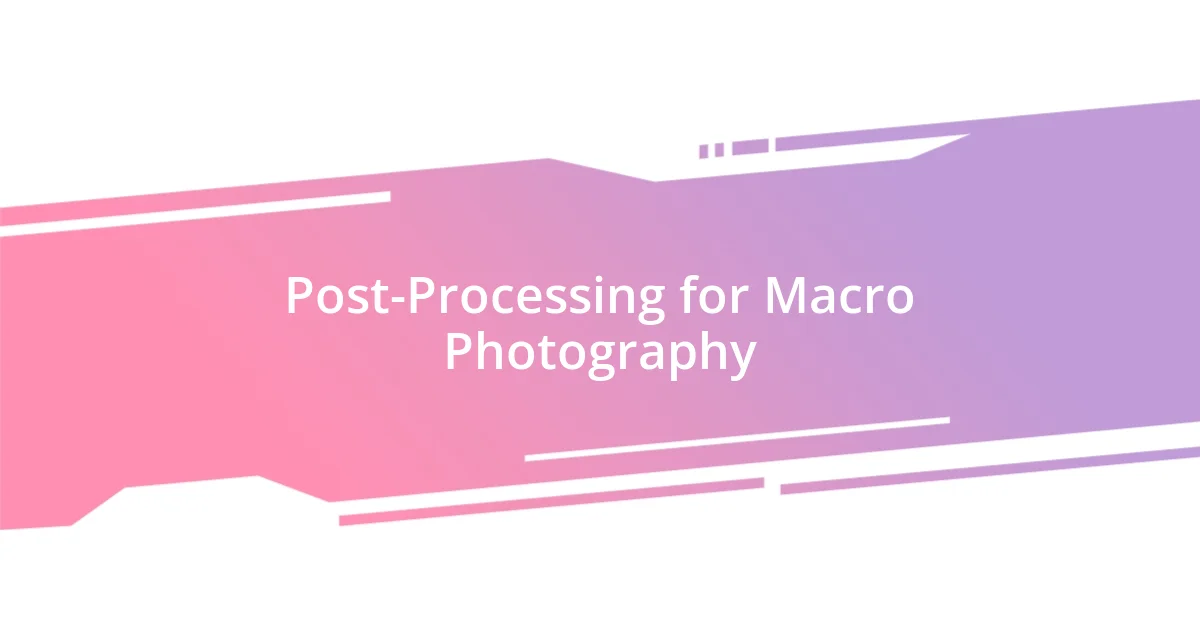
Post-Processing for Macro Photography
Post-processing is where I truly bring my macro images to life. While I strive to capture the perfect shot in-camera, I’ve found that even the best images often need a little refining. For example, I once had a shot of a butterfly that didn’t quite convey the vibrancy I’d witnessed. A quick tweak in contrast and saturation during editing revealed colors I hadn’t realized were hiding in the shadows. It’s fascinating how a few adjustments can evoke the emotion I felt in that moment.
I often use software like Adobe Lightroom, which allows me to highlight minute details that don’t always pop out initially. In one of my recent sessions with flower petals, cropping and sharpening made the delicate textures leap off the screen. Can you relate to that sense of discovery after diving deep into post-processing? The process of uncovering hidden details feels like a treasure hunt, and each adjustment adds depth to my storytelling as a photographer.
I also enjoy manipulating the background during post-processing to maintain focus on the subject. One memorable image featured a beautifully detailed insect against a chaotic backdrop. Blurring the background not only isolated the subject but also amplified the intricate patterns and colors I had captured. I often wonder how much more magic can be created through editing—do you have a favorite technique that helps your photos shine?

Sharing Your Macro Photography Journey
Sharing my macro photography journey has truly opened up an incredible community for me. I remember the first time I shared a close-up shot of an ant carrying a leaf on social media; the feedback was overwhelming. People resonated with the intricacy of nature that I tried to capture, and it was exhilarating to connect with others who share my passion for the tiny details that often go unnoticed. Have you ever felt that rush of validation when someone appreciates your work?
Engaging with fellow macro photographers has enriched my growth significantly. I’ve learned invaluable tips through conversations and critiques; they’ve shaped my perspective in more ways than one. For instance, after discussing depth of field with a mentor, I began experimenting more with shallow focus, which has since become a signature style for my work. Doesn’t it feel amazing how much knowledge can circulate when we share our experiences openly?
There’s something special about sharing not just our successes but also our challenges. After posting a photo of a flower that didn’t turn out quite right, I received suggestions from others who had faced similar hurdles. Their support reassured me that we all encounter bumps in the road, and it’s these shared lessons that create a sense of camaraderie. Have you figured out that some of the best insights often come from our mistakes?
